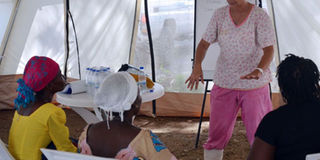Breaking News: KDF chopper crash kills five in West Pokot
French scientists devise faster test for Ebola virus

A nurse working for medical charity MSF speaks to women who survived from the Ebola virus, during a training to become advisers for patients suffering from the disease on October 19, 2014 in Monrovia. A new device similar to a simple pregnancy home-test could allow doctors to diagnose a patient with suspected Ebola in under 15 minutes, its French developers said on October 21, 2014. FILE PHOTO | AFP
What you need to know:
- Similar to a DIY pregnancy test, a positive result sees a small stripe showing up in a results window on the hand-held device.
- Meanwhile, the World Health Organization insisted on Tuesday it would probe complaints that it had been slow to wake up to the scale of Ebola, but insisted the focus now must be on battling the epidemic.
PARIS
A new device similar to a simple pregnancy home-test could allow doctors to diagnose a patient with suspected Ebola in under 15 minutes, its French developers said Tuesday.
Trials at a high-security lab have validated the technique and prototype kits should be available in Ebola-hit countries by the end of October for a clinical trial, France’s Atomic Energy Commission (CEA) said in a statement.
The diagnostic tool, not yet approved by regulators, works by monoclonal antibodies reacting to the presence of virus in a tiny sample, which can be a drop of blood, plasma or urine, it said.
A European pharma company Vedalab is turning it into a user-friendly kit called Ebola eZYSCREEN.
Similar to a DIY pregnancy test, a positive result sees a small stripe showing up in a results window on the hand-held device. The kit is simple to use in the field without any additional equipment, said the CEA, which also does non-nuclear research with a possible military or security application.
“It can give a result in less than 15 minutes for anyone showing symptoms of the disease,” it said.
“Current tests, which are based on genetic detection of the virus, are highly sensitive but need special equipment, take between two and a quarter and two and a half hours and can only be carried out in a lab,” the CEA explained.
PROBE UNDERWAY
Scientists at the agency began working on the diagnostic tool in mid-August, when the epidemic in Guinea, Liberia and Sierra Leone worsened.
The test is for the so-called Zaire ebolavirus, the strain now circulating in West Africa.
This research had “saved more than a year” in development time of the diagnostic test, the CEA said.
Meanwhile, the World Health Organization insisted on Tuesday it would probe complaints that it had been slow to wake up to the scale of Ebola, but insisted the focus now must be on battling the epidemic.
“We know that many elements need to be explained in the future,” said the UN health agency’s spokeswoman Fadela Chaib. “We believe in the virtue of transparency and accountability. WHO will do that, but in the future. Now our focus is on the response,” she told reporters in Geneva.
Critics have questioned why WHO only declared an international health emergency in August, eight months after the epidemic began in Guinea.
The tropical disease, which is proving fatal in 70 percent of cases, has claimed more than 4,500 lives in West Africa, making it the largest Ebola epidemic in history.
Liberia, Sierra Leone and Guinea have been hit hardest, accounting for the overwhelming majority of the 9,200 cases registered in seven countries.
Experts warn that the infection rate could reach 10,000 a week by early December.





